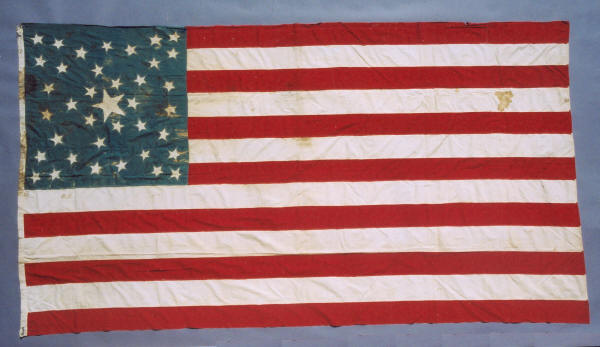
| |
38 STARS IN AN EXCEPTIONALLY RARE "GREAT-STAR-IN-A-WREATH" CONFIGURATION |
|
| Available: |
Sold |
| Frame Size (H x L): |
n/a |
| Flag Size (H x L): |
59" x 105" |
|
| Description....: |
|
| 38 STARS IN AN EXCEPTIONALLY RARE "GREAT-STAR-IN-A-WREATH" CONFIGURATION, 1876-1889, COLORADO STATEHOOD:
38 star American national flag with an extremely rare and beautiful configuration of stars. In the center is a large star, which comprises part of what is known as a "Great Star" or "Great Luminary" design (a large star formation, made up of smaller stars). Surrounding this is a circular wreath of stars, which is flanked by triangles of three stars in each corner. I have not before seen this design and it may not exist on any other Stars & Stripes.
Coveted by collectors, the Great Star is the "Rolls Royce" of geometric patterns. Wreath or medallion designs are also highly desired, and it is very rare to see this combination, which is truly an intermingling of the two traditional forms.
Shortly after the War of 1812, American naval hero, Captain Samuel Reid, suggested to the president that the Great Star should be considered to become the first official star design. Reid's primary concern was that, as more and more states joined the Union, our flag needed to be kept recognizable on the open seas. Naval use was the primary reason for the American ensign in the first place, and Reid's proposal would have kept the star constellation in roughly the same form, and in an easily recognized design that could be quickly identified through a spyglass as the number of states grew.
Reid's proposal was rejected due to the increased cost of arranging the stars in this manner. Never-the-less, since there was no official star pattern, the great star was produced by anyone willing to make it. Its rarity today, along with its beauty, has driven the desirability of American flags with this configuration.
The flag is constructed entirely of cotton that has been pieced with treadle stitching. The stars are single appliqued, which means that they were applied to one side of the canton, then the blue fabric was cut from behind each star, folded under and hemmed so that one appliqued star could be visible on both sides of the flag. I have great admiration for this type of construction, which often results in more irregular, folky, and interesting stars. Penned along the hoist are the words "Made July 3, 1876". This date is not surprising, as elaborate star designs, like this one, are most often associated with the celebration of our nation's 1876 centennial of independence from Great Britain.
The 38th state, Colorado, gained its statehood on August 1st, 1876. The 38 star flag did not become official until July 4th, 1877, but because flag-making was a competitive venture, no one wanted to be making 37 star flags when others were making 38's. So flag makers paid little heed to official star counts and would have begun producing 38 star flags for the nation's centennial, sometime in the early part of 1876. This flag was probably produced in that year, not only because of the hand-written date, but also because flag-makers generally used more interesting designs for the 100-year anniversary of our nation's independence. Medallion and great star patterns are extremely rare after the centennial.
Mounting: The flag is not currently mounted.
Condition: There is moderate staining and color loss in the blue canton. There is a moderate stain near the fly end of the second white stripe. Since flags were typically used outdoors, unlike early quilts and samplers, many collectors actually prefer early flags to show their age and obvious history of use. Further, the great rarity and desirability of the Great-Star-in-a-Wreath configuration warrants practically any condition. |
|
|
|
| Collector Level: |
Advanced Collectors and the Person with Everything |
|
| Flag Type: |
Sewn flag |
|
| Star Count: |
38 |
|
| Earliest Date of Origin: |
1876 |
|
| Latest Date of Origin: |
1889 |
|
| State/Affiliation: |
Colorado |
|
| War Association: |
1866-1889 Indian Wars |
|
| Price: |
No |
|
| |
Views: 2346 |
|
|
|

